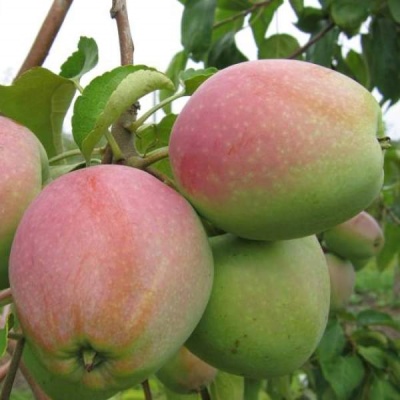
- Authors: Russia, Gornoaltaiskaya expert. base
- Taste: sweet and sour
- Scent: small
- Fruit weight, g: 95-100, maximum 170
- Yield: average yield over 11 years - 29 kg per tree, maximum - 66 kg per tree
- The beginning of fruiting varieties: for 3-4 years
- Ripening terms: winter
- Removable maturity: at the end of September
- Keeping quality: up to 6 months
- Appointment: universal
The name of the Mountain Sinap apple tree sounds mysterious and romantic. But gardeners cannot be satisfied with this, but real information about the origin of the plant is needed. You also need to pay attention to its main properties.
Breeding history of the variety
The Apple tree Mountain Sinap is a well-deserved pride of domestic breeders. The development of this culture was carried out at the Gornoaltaisk experimental base. Breeding work took place in the 1990s. Since 2009, this achievement of Altai plant breeders has been included in the federal register of agricultural crops. Variety tests in the Altai low mountains were carried out successfully, the variety was zoned for Western Siberia.
Description of the variety
Features, pros and cons
Alas, it is impossible to consider the Mountain Sinap apple tree a decoration of the site. Its decorative properties are extremely small, if at all. But as a fruit crop, it is quite promising. The height of the trunk ranges from 2 to 4 m. The crown has a simple round shape, branches are rarely located in it.
At temperatures below -50 degrees, the tree will freeze slightly. But for apple trees, this is already an impressive achievement. Fertility decreases at air temperatures above +37 degrees, as well as at low relative humidity. Such problems are fully compensated for:
early maturity;
stable yields;
a decent level of immunity;
the versatility of the variety.
Ripening and fruiting
The culture belongs to the category of winter apple trees. The first apples can appear in 3 years. Under less favorable conditions - for 4 years. Ripeness for picking fruits is reached by the end of September. Apples can be consumed:
fresh;
in the form of dried fruits;
after processing into juice, compote or jelly;
for obtaining fruit wines, cider;
when making jam, jam, mousse, jelly.
Yield
It has been established that an average of 29 kg of fruits are harvested from a tree per year. The maximum output is 69 kg of apples. This figure is achievable "at the peak of the shape" of the apple tree. Additionally, excellent weather conditions and competent care are required. The plant is fast-growing, which will delight any farmer.
Fruits and their taste
Gorny Sinup apples are versatile. They have a pleasant golden color. In shape, such fruits resemble a cylinder. Other information:
the usual weight of a ripe apple is 95-100 g;
maximum possible weight 170 g;
white, medium density pulp;
high juiciness;
attractive, but not too powerful, aroma;
sweet and sour taste;
the verdict of the tasting examination - 4.7 points;
the level of keeping quality is very high - up to six months.

Growing features
Since the culture is medium-sized, it can be molded infrequently. To plant Mountain Sinap, you need a fertile, moisture-consuming land, illuminated by a bright sun. It must be well permeable to air.Therefore, in the future, it is imperative to follow it, loosen it thoroughly. Of the types of soil, sandy loam and loam are preferred; planting is best done 20-27 days before the onset of frost.



Pollination
Mountain Sinap is a self-fertile plant. Artificial pollination is not required for him. It is also not necessary to specially attract insects.
Top dressing
Agricultural technology of this culture is traditional, and does not represent anything extraordinary. In spring and summer, organic matter needs to be introduced. In the same seasons, nitrogen fertilizers will also come in handy. In the fall, it's time to feed the tree with potassium and phosphorus. Dosages - according to the instructions.

Frost resistance
The apple tree is able to withstand the cold quite well. However, you should not abuse this ability of her. When grown in the middle lane, the culture must be covered. Slight freezing is possible during a particularly harsh season. It is worth noting that Mountain Sinup can compensate for such damage rather quickly if the plant is properly helped.

Diseases and pests
The Mountain Sinap apple tree tolerates the effects of scab well. The chance of contracting this serious disease is zero. Resistance to other dangerous ailments of fruit trees is quite high. There is no information on any specific pests for this variety. Therefore, planting must be equally protected from any harmful insects.

The apple tree is a popular fruit crop among gardeners. It can be found in many summer cottages. But at the same time, such trees are often affected by various diseases. It is very important to recognize the disease in time and carry out the necessary procedures for a speedy recovery. Otherwise, the fruits will be spoiled, and the tree itself may die altogether.












































































